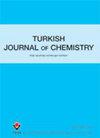A facile tert-butyl nitrite-assisted preparation of deamino graphitic carbon nitride (DA-gCN) as a photocatalyst for the C-H arylation of heteroarenes using anilines as radical source
IF 1.3
4区 化学
Q3 CHEMISTRY, MULTIDISCIPLINARY
引用次数: 0
Abstract
In pristine graphitic carbon nitride (g-CN), amino groups often function as structural defects that trap photogenerated charges, resulting in low photocatalytic activity as well as reaction with nitrite, aldehyde, etc., ensuing in poor product yield. Without significantly altering the optical characteristics, the removal of amino groups is necessary to increase the photocatalytic activity and structural stability of pristine g-CN. The deamino graphitic carbon nitride (DA-gCN-5) was prepared by tert-butyl nitrite (TBN)- treatment, characterized and used as a photocatalyst for the radical C-H arylation of heteroarenes using anilines as radical source. Indeed, the photophysical characteristics of DA-gCN-5 and those of pristine g-CN are very comparable, except that DA-gCN-5 has a fewer residual amino groups, higher crystallinity, and compressed structure with a different morphology. Moreover, DA-gCN-5- catalyzed C-H arylation reaction offers greater product yield in a shorter reaction time compared to that of pristine g-CN in the coupling between heteroarenes and the in situ generated aryl diazonium salts from anilines under visible light irradiation. The amino groups in pristine g-CN absorbed the TBN that was added to convert aniline into the appropriate diazonium ions during the reaction. As a result, deamino graphitic carbon nitride produced by chemical treatment has better photophysical properties and catalytic activity than pristine g-CN. Additionally, this is the first method that uses diazotization reaction for the preparation of deamino graphitic carbon nitride, as far as we are aware.以苯胺为自由基源,亚硝酸盐叔丁基辅助制备脱氨基石墨氮化碳(DA-gCN)作为杂芳烃C-H基化的光催化剂
在原始石墨氮化碳(g-CN)中,氨基常作为结构缺陷捕获光生电荷,导致光催化活性低,与亚硝酸盐、醛等反应,产物收率低。在不显著改变光学特性的情况下,去除氨基是提高原始g-CN光催化活性和结构稳定性的必要条件。采用亚硝基叔丁基(TBN)法制备了脱氨基石墨氮化碳(DA-gCN-5),对其进行了表征,并以苯胺为自由基源,用作杂芳烃自由基C-H基化反应的光催化剂。事实上,DA-gCN-5的光物理特性与原始的g-CN非常相似,只是DA-gCN-5的残余氨基更少,结晶度更高,结构压缩,形态不同。此外,在可见光照射下,DA-gCN-5催化的C-H芳基化反应比原始g-CN在杂芳烃和苯胺原位生成芳基重氮盐的偶联反应在更短的反应时间内获得了更高的产物收率。原始g-CN中的氨基吸收了在反应过程中加入的将苯胺转化为适当重氮离子的TBN。结果表明,化学处理得到的脱氨基石墨氮化碳具有比原始g-CN更好的光物理性能和催化活性。此外,这是据我们所知的第一个利用重氮化反应制备脱氨基石墨氮化碳的方法。
本文章由计算机程序翻译,如有差异,请以英文原文为准。
求助全文
约1分钟内获得全文
求助全文
来源期刊

Turkish Journal of Chemistry
化学-工程:化工
CiteScore
2.40
自引率
7.10%
发文量
87
审稿时长
3 months
期刊介绍:
The Turkish Journal of Chemistry is a bimonthly multidisciplinary journal published by the Scientific and Technological Research Council of Turkey (TÜBİTAK).
The journal is dedicated to dissemination of knowledge in all disciplines of chemistry (organic, inorganic, physical, polymeric, technical, theoretical and analytical chemistry) as well as research at the interface with other sciences especially in chemical engineering where molecular aspects are key to the findings.
The journal accepts English-language original manuscripts and contribution is open to researchers of all nationalities.
The journal publishes refereed original papers, reviews, letters to editor and issues devoted to special fields.
All manuscripts are peer-reviewed and electronic processing ensures accurate reproduction of text and data, plus publication times as short as possible.
 求助内容:
求助内容: 应助结果提醒方式:
应助结果提醒方式:


